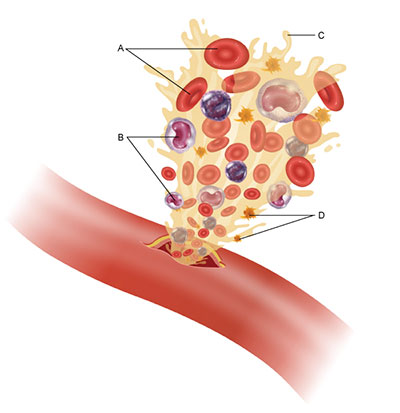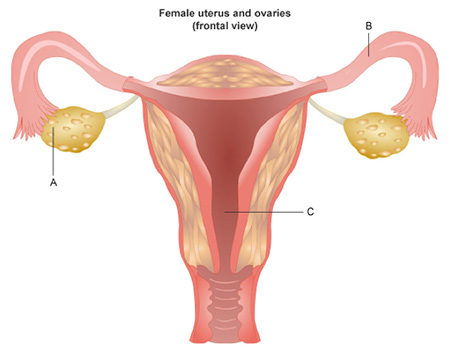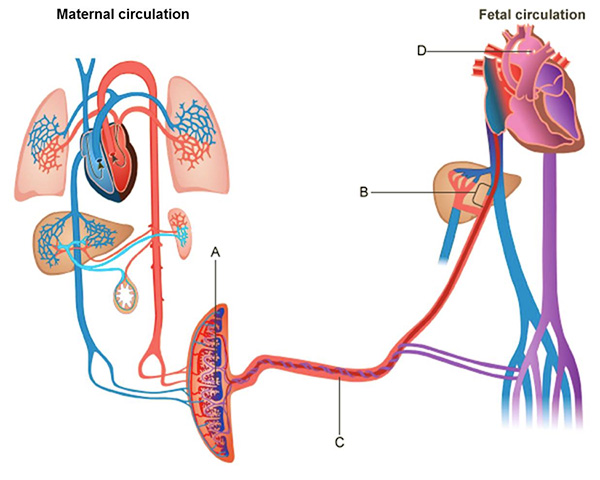Human Anatomy Final (34 multiple Choice, 2 Short Answer)
1.
(04.01 LC)
A patient does not have a family history of hypertension. This means which of the following? ( 2 points)
2.
(06.02 MC)
Which of the following are examples of the physical and chemical nonspecific immune system? (2 points)
3.
(06.02 MC)
What are the functions of T memory cells? (2 points)
4.
(04.01 MC)
Which of the following would create the second heart sound? (2 points)
5.
(06.04 MC)
Which of the following groups of organs provide secretions that nourish and protect sperm cells? (2 points)
6.
(04.02 MC)

Image Courtesy of 3DScience.com
Based on the diagram above, which of the labeled constituents carry oxygen from the lungs to other cells in the body? (2 points)
7.
(04.03 MC)
Hemostasis involves which of the following components? (2 points)
8.
(05.02 MC)
Which of the following correctly describes the structure and its function? (2 points)
9.
(04.02 LC)
Which of the following is the largest component of blood plasma? (2 points)
10.
(06.02 LC)
A person who was infected with many common diseases as a child will contain more of which of the following compared to a child who was not exposed to many diseases? (2 points)
11.
(04.02 MC)
According to the National Institute of Health, peripheral arterial disease (PAD) happens when there is a narrowing of the blood vessels outside of your heart. The cause of PAD is atherosclerosis. This can reduce or stop blood flow, usually to the legs, causing them to hurt or feel numb. If severe enough, blocked blood flow can cause tissue death. If this condition is left untreated, a foot or leg may need to be amputated.
Based on the passage above, which of the following would indicate PAD? (2 points)
12.
(04.02 LC)
Which of the following is an example of a disease that is properly matched with one of its environmental risk factors? (2 points)
13.
(04.05 HC)
Slowing down or stopping an activity because you can’t catch your breath is one sign of COPD, chronic obstructive pulmonary disease. In COPD the airways of the lungs are narrowed, and this makes it hard to get air out and causes an “out of breath” feeling. Other symptoms of COPD can include frequent coughing, excess mucus, and sometimes wheezing. Some patients with COPD also show loss of lung tissue on chest x-rays-a condition called “emphysema.”
Explain what is meant by the statement: “In COPD the airways of the lungs are narrowed.” Specifically, what part of the respiratory system will be narrowed? Then explain how emphysema could lead to shortness of breath. Be sure to identify and describe the specific tissues involved. (5 points)
14.
(06.02 MC)
Where is urea produced, and where is it removed from the blood? (2 points)
15.
(05.01 MC)
A tear in the right rib muscles has caused the muscles to spasm, meaning they are locked in a contracted state. How would this affect breathing in the right lung? (2 points)
16.
(04.01 MC)
How does smoking and arterial plaques increase the risk of hypertension? (2 points)
17.
(05.01 MC)
Abdominal breathing is a condition in which only the inferior half of the lungs can be seen expanding and contracting with each breath. Which of the following would cause abdominal breathing? (2 points)
18.
(04.03 LC)
What is the definition of hemostasis? (2 points)
19.
(05.04 MC)

© Public Domain
In the enzyme reaction above, catechol is the substrate, oxygen is a reactant, catechol oxidase is the enzyme, benzoquinone is the product, and water (H2O) is a by-product. Which of the following will decrease the rate of this reaction? (2 points)
20.
(06.03 MC)
What is the name and function of the main lymphatic tissue found in the intestines? (2 points)
21.
(04.01 MC)
Exercise can reduce the amount of arterial plaque in blood vessels. Which of the following effects would this produce on the circulatory system? (2 points)
22.
(06.03 MC)
Which of the following describes the function of lymph nodes? (2 points)
23.
(05.02 MC)
Which of the following would accompany a high-protein meal moving through the digestive system? (2 points)
24.
(06.01 HC)
People who suffer renal failure are treated with a medical process called dialysis. A dialysis machine carries out the role of the kidneys. Explain the functions that a dialysis machine must perform in order to carry out the work of the kidneys. In your answer, include which structures of a working kidney carry out each function. (5 points)
25.
(04.02 MC)
According to the National Institute of Health, ventricular tachycardia is a fast, regular beating of the ventricles that may last for only a few seconds or for much longer. A few beats of ventricular tachycardia often doesn’t cause problems. However, episodes that last for more than a few seconds can be dangerous. Ventricular tachycardia can turn into other, more serious arrhythmias, such as ventricular fibrillation.
Based on the passage above, how will prolonged ventricular tachycardia affect blood pressure? (2 points)
26.
(05.04 MC)
Which of the following would increase the rate of an enzyme-catalyzed reaction? (2 points)
27.
(04.01 LC)
Which of the following prevents blood from flowing backward through the circulatory system? (2 points)
28.
(04.01 MC)
Arteries gradually constrict between each heartbeat. This would allow for which of the following? (2 points)
29.
(06.04 MC)

Based on the diagram above, which best describes the structure and function of C? (2 points)
30.
(05.02 MC)
How does acetylcholine influence chemical and physical digestion? (2 points)
31.
(06.05 MC)

© Image Courtesy of 3DScience.com
Based on the diagram above, which of the following describes the role of organ A? (2 points)
32.
(06.01 MC)
According to the National Institute of Health, adhesions are bands of fibrous tissue. They can connect the loops of the intestines to each other, to nearby organs, or to the wall of the abdomen. They can pull sections of the intestines out of place. This may block food from passing through the intestine. Adhesions can sometimes cause infertility in women by preventing fertilized eggs from reaching the uterus.
What is one way that an adhesion could prevent fertilized eggs from reaching the uterus? (2 points)
33.
(04.02 MC)
Which of the formed elements of blood is primarily involved in clotting? (2 points)
34.
(06.03 MC)
Which of the following would increase the spread of cancer through the body? (2 points)
35.
(05.03 MC)
Why are nucleic acids not considered a nutrient? (2 points)
36.
(05.02 MC)
Which of the following would increase the rate of an enzyme-catalyzed reaction? (2 points)
